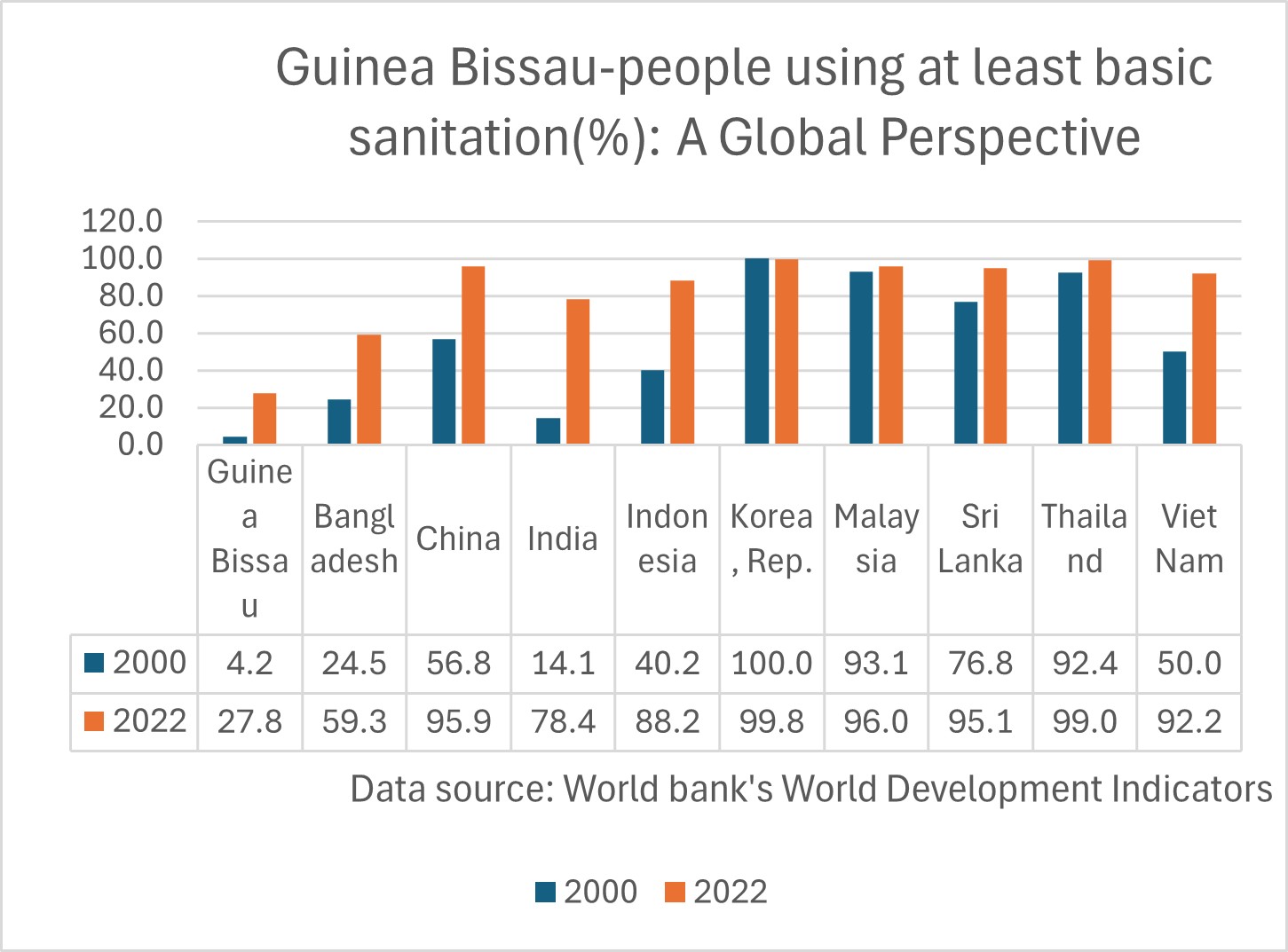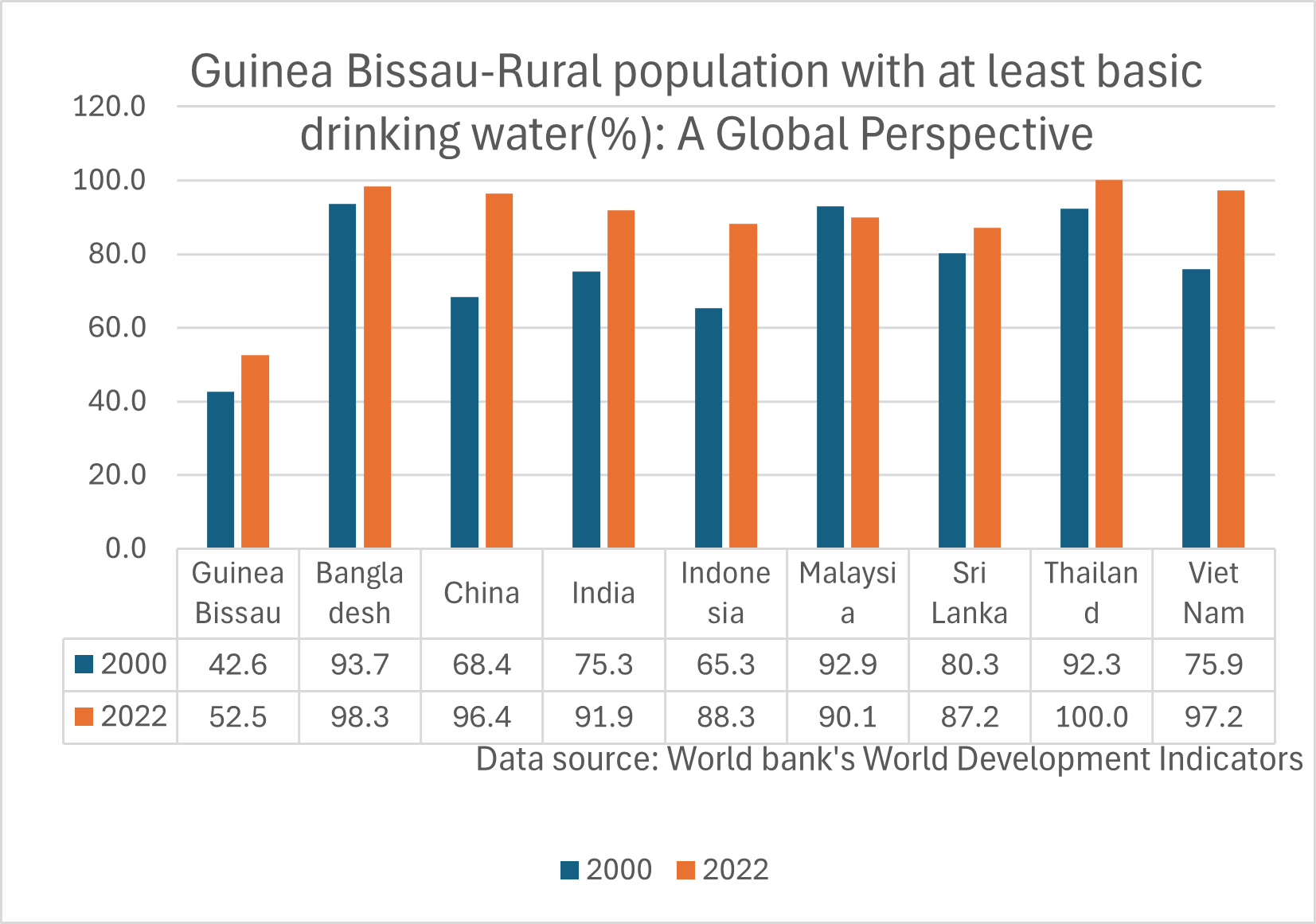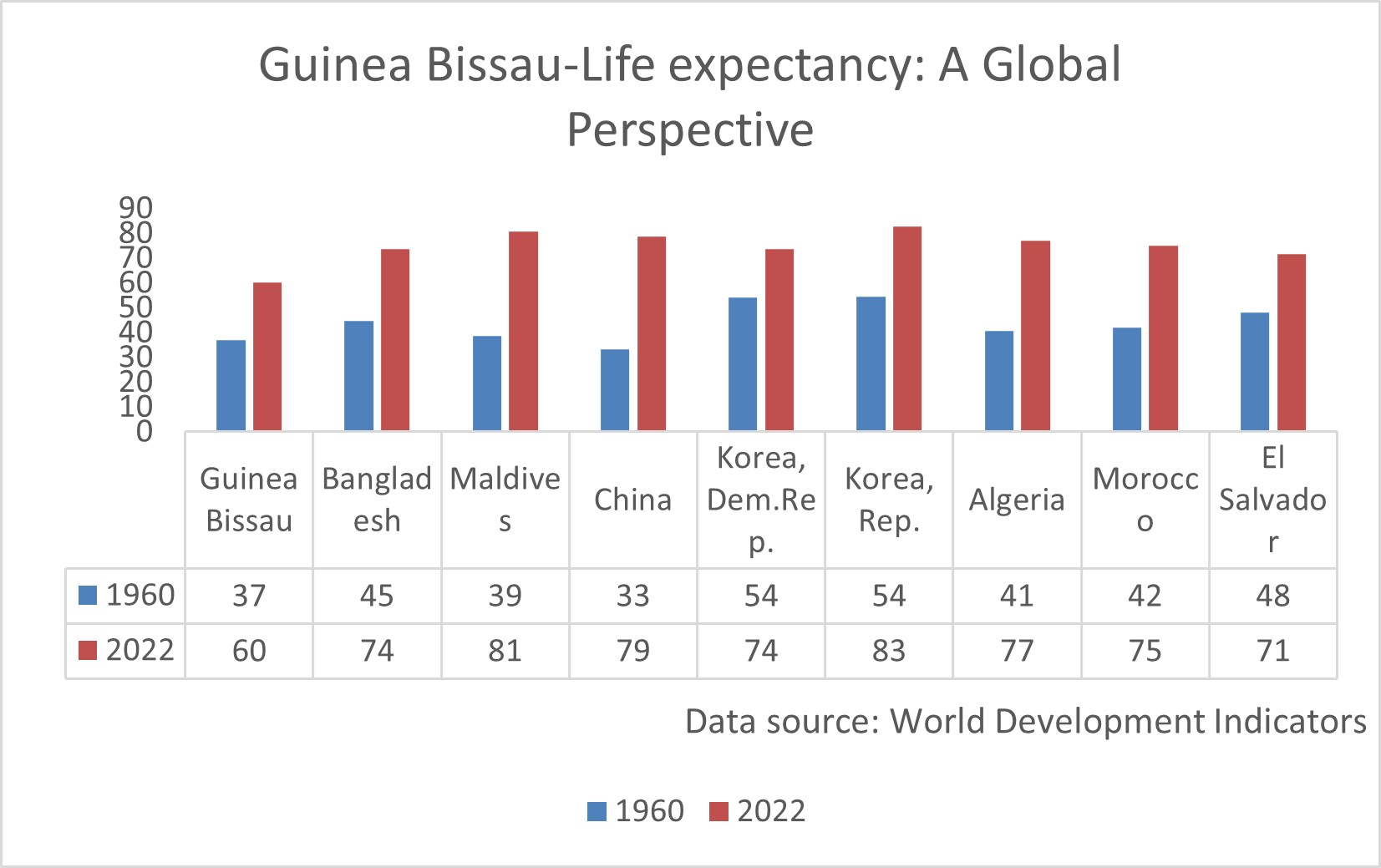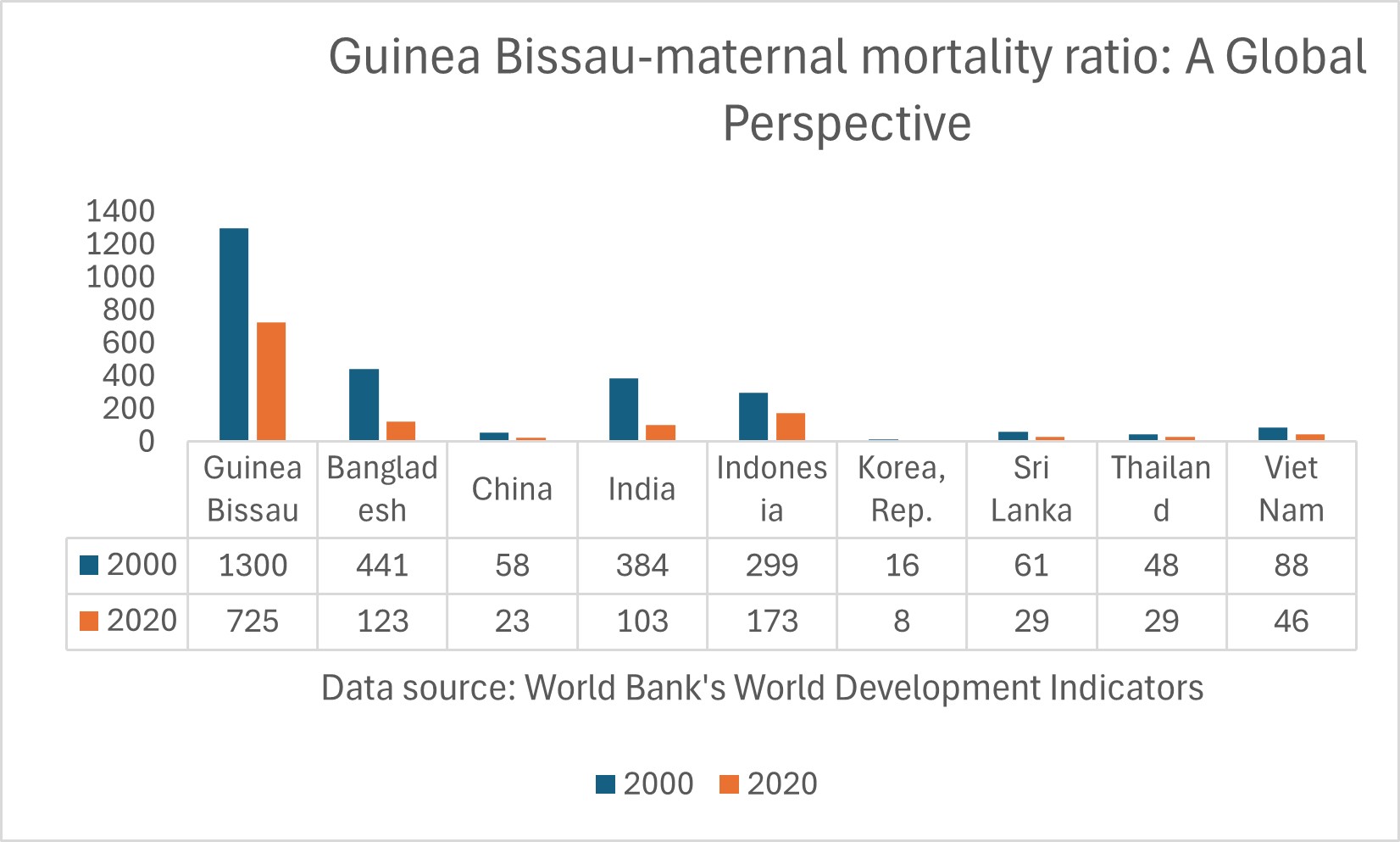
Guinea Bissau
Country Flag Details: two equal horizontal bands of yellow (top) and green with a vertical red band on the hoist side; there is a black five-pointed star centered in the red band; yellow symbolizes the sun; green denotes hope; red represents blood shed during the struggle for independence; the black star stands for African unity.
note: uses the popular Pan-African colors of Ethiopia; the flag design was heavily influenced by the Ghanaian flag.
Background Since independence from Portugal in 1974,
Guinea-Bissau has experienced
considerable political and military upheaval. Guinea-Bissau’s history of political instability, a civil war, and several coups (the latest in 2012) have resulted in a fragile state with a weak economy, high unemployment, rampant corruption, and widespread poverty.

Geography
Area
total : 36,125 sq km
land: 28,120 sq km
water: 8,005 sq km
Climate
tropical; generally hot and humid;
monsoonal-type rainy season (June to
November) with southwesterly winds; dry
season (December to May) with
northeasterly harmattan winds
Natural resources
fish, timber, phosphates, bauxite, clay,
granite, limestone, unexploited deposits of
petroleum
People and Society
Population
total: 2,132,325
Ethnic groups
Balanta 30%, Fulani 30%, Manjaco 14%,
Mandinga 13%, Papel 7%, unspecified
smaller ethnic groups 6% (2015 est.)
Languages
Portuguese-based Creole, Portuguese
(official; largely used as a second or third language), Pular (a Fula language),
Mandingo
Religions
Muslim 46.1%, folk religions 30.6%,
Christian 18.9%, other or unaffiliated 4.4%
(2020 est.)
Population growth rate
2.54% (2024 est.) Government
Government type
semi-presidential republic
Capital name: Bissau
Executive branch
chief of state: President Umaro Sissoco
EMBALO (since 27 February 2020)
head of government: Prime Minister Rui
Duarte DE BARROS (since 20 December
2023)
Economy
Real GDP (purchasing power parity)
$5.553 billion (2023 est.)
$5.279 billion (2022 est.)
$5.046 billion (2021 est.)
Real GDP per capita
$2,600 (2023 est.)
$2,500 (2022 est.)
$2,500 (2021 est.)
Exports
$280.065 million (2022 est.)
$334.904 million (2021 est.)
$232.536 million (2020 est.)
Exports – partners
India 66%, Chile 9%, Cote d’Ivoire 5%,
Ghana 4%, Netherlands 3% (2023)
Exports – commodities
coconuts/brazil nuts/cashews, fish, fish oil,
processed crustaceans, malt extract (2023)
Imports
$577.899 million (2022 est.)
$518.162 million (2021 est.)
$439.386 million (2020 est.)
Imports – partners
Senegal 28%, Portugal 24%, China 11%,
Gambia, The 10%, Pakistan 4% (2023)
Imports – commodities
refined petroleum, iron bars, rice, plastics,
flavored water (2023)

Export structure by product groups in 2023 (% of total export) (UNCTAD)
The export structure of a country reflects the diversity, composition, and value of the goods and services it trades internationally, providing vital insights into its economic health, competitiveness, and development stage. In Guinea-Bissau, the export structure is primarily focused on agricultural products, with cashew nuts serving as the leading contributor. The economy heavily depends on agriculture and fishing, with cashew nuts being critical to its export revenues. This reliance on a single commodity makes the country vulnerable to fluctuations in global cashew markets. To foster economic stability and growth, it is essential for Guinea-Bissau to diversify its export base and increase the value of its agricultural products.

Poverty and vulnerable employment in Guinea Bissau (World Bank)
Understanding poverty level significance at $2.15 per day
In 2021, 26 percent of the population of Guinea Bissau lived in poverty at $2.15 per day. The poverty level at $2.15 per day (measured in 2017 purchasing power parity, or PPP) is a key global benchmark used by the World Bank to define extreme poverty in low-income countries. It indicates:
1. Basic Survival Threshold
• People living below $2.15 per day struggle to afford essential needs such as food, clean water, shelter, healthcare, and education.
2. Economic Underdevelopment
• A high percentage of a country’s population living below this threshold suggests low economic productivity, high unemployment, and weak social safety nets.
3. Inequality and Social Vulnerability
• It reflects deep income inequality and a lack of access to opportunities for upward mobility.
• People in this category are more vulnerable to shocks like food price increases, climate disasters, or health crises.
4. Policy Challenges
• Governments need targeted interventions such as social welfare programs, job creation, and improved access to education and healthcare to reduce poverty.
A country's export structure is a reflection of its level of development and its productive capacities
The export structure of a country refers to the composition, diversity, and value of the goods and services it sells to other countries. It provides key insights into the country’s economic health, competitiveness, and level of development. Productive capacities of a country refer to its ability to produce goods and services efficiently and sustainably over time. These capacities are shaped by various factors, including human capital, natural resources, infrastructure, private sector, development, technology & innovation, institutions & governance, financial systems trade & market access.
Here’s what the export structure and productive capacities of a country typically indicate:
- Level of Economic Development
- Developed economies usually export high-value manufactured goods, technology, and services.
- Developing economies often rely on raw materials, agricultural products, or low-value manufactured goods.
- Industrial and Sectoral Strengths
- A strong presence of high-tech or industrial goods (e.g., machinery, electronics) suggests a well-developed manufacturing sector.
- A dominance of commodities (e.g., oil, minerals, agricultural products) indicates reliance on natural resources.
- Export Diversification
- A diverse export base (multiple industries) makes a country’s economy more stable and resilient to global price shocks.
- A concentrated export base (few key products) makes it vulnerable to market fluctuations.
- Trade Partnerships and Dependence
- If exports are heavily dependent on a single country or region, the economy is more exposed to geopolitical and trade risks.
- A wide range of trading partners indicates stronger global integration.
- Competitiveness and Value Addition
- Exporting mainly raw materials (e.g., crude oil instead of refined petroleum) suggests limited industrial processing capacity.
- A high share of finished and high-tech goods suggests strong value addition and competitiveness.
Guinea Bissau-Sanitation
Guinea Bissau – Proportion of population served with at least basic sanitation
In 2022, proportion of population served with at least basic sanitation for Guinea Bissau was 27.8 %. Proportion of population served with at least basic sanitation of Guinea Bissau increased from 4.2% in 2000 to 27.8 % in 2022%, an absolute change of 23.6 percentage points (pp) between 2000 and 2022.
Guinea Bissau – Proportion of urban population served with at least basic sanitation
In 2022, proportion of urban population served with at least basic sanitation for Guinea Bissau was 42.1 %. Proportion of urban population served with at least basic sanitation of Guinea Bissau increased from 11.5 % in 2000 to 42.1 % in 2022 , an absolute change of 30.6 pp between 2000 and 2022.
Guinea Bissau – Proportion of rural population served with at least basic sanitation
In 2022, proportion of rural population served with at least basic sanitation for Guinea Bissau was 16.2 %. Proportion of rural population served with at least basic sanitation of Guinea Bissau increased from 0.0 % in 2000 to 16.2 % in 2022 an absolute change of 16.2pp between 2010 and 2022.
Guinea Bissau – Proportion of population without at least basic sanitation: A Global Perspective
The ongoing lack of safe sanitation represents a critical issue that demands immediate and concerted action, resulting in the preventable deaths of hundreds of thousands of individuals every year and highlighting a significant public health crisis that cannot be overlooked. Safe sanitation is not merely a basic necessity; it is an essential human right that every individual deserves access to without exceptions. In 2022, approximately 1.5 million people, representing nearly 72% of Guinea Bissau’s overall population, encountered the severe consequences of inadequate sanitation facilities, a stark disparity when compared to other nations. For example, countries such as Vietnam, China, and Thailand reported much lower figures, with only 8%, 5%, and a mere 1% of their populations lacking these vital services. Meanwhile, the global average of individuals without access to sanitation facilities hovers around 6%, underscoring the urgent need to prioritize unity and collaborative efforts aimed at enhancing sanitation access in most countries of Sub-Saharan Africa.

Guinea Bissau – Share of rural population without at least basic sanitation: A Global Perspective
In 2022, nearly 1 million individuals in the rural areas of Guinea Bissau, representing around 83.8% of this population, were without access to basic sanitation facilities, highlighting a profound disparity when compared to countries like Vietnam, Sri Lanka, and Thailand, which reported figures of just 12%, 5%, and 2% respectively. The absence of safe sanitation is not merely an urgent issue to be addressed, it also constitutes a serious concern that demands immediate and united action. Safe sanitation transcends a mere basic requirement; it is fundamentally recognized as an essential human right. Therefore, it is crucial to mobilize our efforts to uphold and advocate for this vital right across Sub-Saharan Africa, where the need is most pressing.

Guinea Bissau-Water Supply
Guinea Bissau – Proportion of total population served with at least basic water
n 2022, proportion of population served with at least basic water for Guinea Bissau was 61.8 %. Proportion of population served with at least basic water of Guinea Bissau increased from 55.3 % in 2000 to 61.8 % in 2022 an absolute change of 6.5 pp between 2000 and 2022.
Guinea Bissau – Proportion of urban population served with at least basic water
In 2022, proportion of urban population served with at least basic water for Guinea Bissau was 73.1 %. Proportion of urban population served with at least basic water of Guinea Bissau fell gradually from 77.6 % in 2000 to 73.1 % in 2022, an absolute change of 4.5 pp between 2000 and 2022.
Guinea Bissau – Proportion of rural population with at least basic water
In 2022, proportion of rural population served with at least basic water for Guinea Bissau was 52.5 %. Proportion of rural population served with at least basic water of Guinea Bissau increased from 42.6 % in 2000 to 52.5 % in 2022 an absolute change of 9.9 pp between 2000 and 2022.
Guinea Bissau – Proportion of total population not served with at least basic water: A Global Perspective
Access to safe drinking water is a fundamental human need and a crucial human right that is vital for health and well-being. It is deeply concerning that in 2022 nearly 800,000 people in Guinea Bissau, which constitutes around 38% of the population, were deprived of this essential resource, laying bare a significant inequality in access to basic necessities that many take for granted. In stark contrast, every individual in Thailand had access to safe drinking water, while an impressive 98% of the populations in both Bangladesh and Vietnam enjoyed this same critical right. These glaring disparities serve to highlight the pressing necessity for compassionate and coordinated actions aimed at improving living conditions and ensuring fair access to safe drinking water for vulnerable communities across Sub-Saharan Africa, where the consequences of such inequities are dire and demand our immediate attention and intervention.

Guinea Bissau – Proportion of rural population not served with at least basic water: A Global Perspective
In 2022, a distressing 47.5% of the rural population in Guinea Bissau lacked access to drinking water facilities, translating to roughly 550 thousand individuals within these communities being deprived of safe drinking water sources that are essential for health and well-being. This sobering reality stands in stark contrast to nations such as Thailand and Bangladesh, where a remarkable 100% and 98% of their rural populations, respectively, enjoyed access to safe drinking water during the same year. This significant disparity not only highlights the dire situation faced by millions in Guinea Bissau but also underscores the urgent necessity for transformative action across Sub-Saharan African countries. It reinforces the critical need to confront and address the fundamental issues surrounding water accessibility and sustainability in this region.

Guinea Bissau- Access to Electricity
Guinea Bissau-Access to electricity (% of population)
In 2022, proportion of population with access to electricity for Guinea Bissau was 37.4 %. The proportion of population with access to electricity of Guinea Bissau increased from 6% in 2010 to 37.4% in 2022, an absolute change of 31.4 pp between 2010 and 2022.
Guinea Bissau-Access to electricity (% urban population)
In 2022, proportion of urban population with access to electricity for Guinea Bissau was 61%. The proportion of urban population with access to electricity of Guinea Bissau increased from 23.8% % in 2000 to 61% in 2022, an absolute change of 37.2 pp between 2000 and 2022.
Guinea Bissau-Access to Electricity (% rural population)
In 2022, proportion of rural population with access to electricity for Guinea Bissau was 15.8 %. The proportion of rural population with access to electricity of Guinea Bissau increased from 0.0 % % in 2000 to 15.8% in 2022, an absolute change of 16 pp between 2010 and 2022.
Guinea Bissau-Total population without access to electricity: A Global Perspective
In 2022 nearly 63% of Guinea Bissau’s population was devoid of access to electricity highlighting a significant disparity where more than half of its residents lack this essential service for daily living and economic activities. This stands in stark contrast to countries like Vietnam, Thailand, Sri Lanka, and Malaysia, which have successfully achieved 100% electricity access, underscoring the urgent need for comprehensive reforms in Sub-Saharan Africa to improve the overall quality of life for its citizens. Access to reliable electricity is not just a matter of convenience; it is a fundamental necessity that can drive development, health education, and economic growth thereby enhancing living standards in these regions and creating opportunities for a brighter future.

Guinea Bissau-Rural population without access to electricity: A Global Perspective
In 2022, a staggering 84% of the rural population in Guinea Bissau faced the harsh reality of living without electricity, which vividly highlights a profound disparity compared to countries such as Vietnam, Thailand, and Sri Lanka, where every individual in rural areas enjoys full access to this crucial resource. Even in countries like India and Bangladesh, an impressive 99% of the rural populace has the benefit of electricity in their daily lives. These figures extend beyond mere statistics; they emphasize the pressing necessity for sincere and transformative reforms in governance throughout Sub-Saharan Africa to ensure that every community is empowered with reliable access to electricity, enabling them to thrive and progress toward a more sustainable future.

Guinea Bissau- Health outcomes
Guinea-Bissau-Life expectancy: A Global Perspective
The global average life expectancy for newborns has risen impressively from 47 years in 1950 to 71 years by 2021; however, the progress in many Sub-Saharan African nations remains alarmingly limited. For instance, Guinea Bissau’s life expectancy has improved from a mere 37 years in 1960 to just 60 years in 2022, reflecting the ongoing adversities faced by its citizens. In sharp contrast, countries like South Korea have experienced extraordinary advancements, with life expectancy soaring from 54 years in 1960 to an impressive 83 years in 2022, and the Maldives has also made remarkable gains, rising from 39 years in 1960 to 81 years in 2022. The persistently low life expectancy in numerous Sub-Saharan African nations is a stark reminder of the complex and urgent challenges they confront, which include chronic poverty, underfunded healthcare systems, and issues of governance. These factors demand immediate and transformative actions to pave the way for a sustainable and equitable future for their communities, ensuring that the benefits of global progress are shared by all.

Guinea Bissau-Mortality rate, under-5 (per 1000 live births): A Global Perspective
Since 1950, child mortality rates worldwide have experienced a significant and encouraging decline, a trend largely attributed to improvements in living standards, healthcare access, nutrition, and the availability of safe drinking water. In the wealthiest nations in Europe and America, child mortality has dropped dramatically to less than 4 percent, highlighting the benefits of robust healthcare systems and socioeconomic stability. Over the past seven decades, various developing countries in South America, Asia, and Africa have made notable advancements; however, progress in many Sub-Saharan African nations remains gradual and uneven. For instance, the under-five mortality rate in Guinea Bissau has decreased from a staggering 174 in 2000 to a more favorable 72 in 2022. In contrast, Bangladesh has achieved a remarkable reduction in child mortality, plummeting from 206 in 1980 to an impressive 29 in 2022, while India has mirrored this success, reducing its rate from 169 in 1980 to a striking 29 in 2022. These statistics underscore the formidable challenges that persist due to inadequate healthcare systems and highlight the urgent necessity for comprehensive structural reforms in governance across Sub-Saharan Africa to further combat child mortality and improve overall health outcomes.

. Guinea Bissau-Maternal mortality ratio (per 100,000 live births): A Global Perspective
Guinea Bissau’s maternal mortality ratio, while it has seen a concerning decline from 1300 in 2000 to 725 in 2020, still reflects an extraordinarily high figure that underscores the dire situation facing mothers in the nation. This change, though noteworthy, remains deeply troubling when juxtaposed with the maternal mortality ratios of Bangladesh, India, and Vietnam, which were recorded at 123, 103, and 46 respectively in 2022. Such a significant disparity reveals that a distressing number of pregnancy-related deaths during this time-frame occurred in Guinea Bissau, a scenario made worse by the nation’s high birth rate, coupled with persistently high maternal mortality statistics. These alarming figures highlight not only the critical deficiencies in healthcare but also the chronic under-funding that plagues healthcare systems in many Sub-Saharan African countries. The striking contrast in maternal health outcomes compared to other developing regions serves as a compelling call to action, emphasizing the urgent necessity for substantial improvements in health infrastructure in many nations across Sub-Saharan Africa
